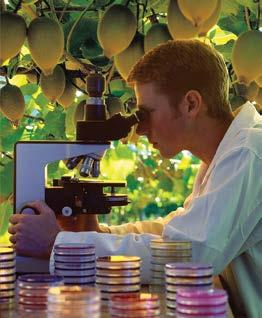
64 minute read
PAC KAGING
Shelf life, food waste and plastics
Gordon Robertson, FNZIFST
Introduction Globally, some 1.3 billion tonnes of edible food go to waste every year, equal to more than two tonnes of wasted food per hungry person per year. In the UK it has been estimated that around 70% (by weight) of wasted food arises in households. It is recognised that shelf life prolongation could play a key role in reducing food waste but the real relationship between shelf life and food waste is not well understood for lack of actual consumer data. Many consumers intuitively know that the quality of most foods and beverages decreases over time, and therefore there will be a finite length of time before the food becomes unacceptable, this time being referred to as shelf life. Visible date labels became widespread in the 1970s in many countries in response to consumer demand for transparency regarding food freshness. Today, date marking of packaged foods is used to guide consumers on how long food can be kept before it becomes unacceptable or unsafe to eat.
Regulations and conventions on date marking The date marking of foods is regulated by the Australia New Zealand Food Standards Code – Standard 1.2.5 ‘Information requirements – date marking of food for sale’ which specifies the required wording and form. Food for sale must be date marked on labels with either a ‘use by’ or a ‘best before’ date and is the responsibility of the food manufacturer. An exception is given for bread that has a shelf life of less than 7 days which may be labelled with the ‘best-before’, ‘baked-for’ or ‘baked-on’ date. Unless the food is an infant formula product, date marking is not required if the ‘best before’ date of the food is 2 years or more which is the case for many canned foods. A food must not be sold after its ‘use by’ date. Section 1.2.5—5 does not prevent the addition of a packed-on date or a manufacturer’s or packer’s code on the label of a package of food. In many countries 75% of shelf life must remain on receipt of the food into supermarket warehouses. The ‘best before’ date, sometimes shown as BBE (best before end), is about quality and not safety. The food will be safe to eat after this date but may not be at its best. A ‘use by’ date on food is about safety; foods can be eaten until the ‘use by’ date but not after. While most countries have standardised their date labelling, the US does not yet have federal regulations standardising the use of date labels on foods other than infant formula. Food date labels such as ‘best before’ and ‘use by’ are largely unregulated, although voluntary industry standards have recently been developed and are coming into effect. Anheuser-Busch began promoting freshness dating as a ‘born The term ‘often good after’ used on a food package
on’ date in 1996 and considered its beer to be fresh for four months (110 days) from the ‘born on’ dates on the bottles or cans. In 2009, this was extended to 180 days after they were taken over by InBev. In 2015 the ‘born on’ date was replaced with a 'freshest before' date. In May 2019 Dr Frank Yiannas, Deputy Commissioner with the US FDA, released a letter to the food industry in which he noted that food waste by consumers often results from fears about food safety caused by misunderstanding of what the descriptive phrases on food date labels mean, along with uncertainty about storage of perishable foods. It has been estimated that confusion over date labelling accounts for approximately 20% of consumer food waste in the US. The FDA regulates approximately 80% of the foods in the US and they strongly support industry’s voluntary efforts to use the ‘best if used by’ phrase as a quality-based date label. The FDA is not addressing the use of a ‘use by’ product date label for safety reasons at this time. However, labelling is not enough and the FDA supports ongoing consumer education efforts by industry, government, and non-government organisations to educate consumers on what quality-based date labels mean and how to use them to further reduce food waste in the home. According to the European Commission, approximately a third of food waste created at the household level could be linked to consumer misunderstanding of the meaning of date marking. A study in Milan found only 47% of consumers could correctly understand the meaning of the ‘best before’ date. Recently the term ‘often good after’ has been introduced as a result of collaboration between Danish food waste start-up Too Good To Go and a number of food manufacturers, including Unilever, Carslberg and Arla Foods. Too Good To Go CEO Mette Lykke has claimed that 53% of Europeans don't know the difference between 'best before' and 'use by'
when it comes to food labelling. Many in Denmark where she lives think that ‘best before’ means ‘worst after’ and throw food out to be on the safe side. This is a concern as food waste contributes to 8% of global greenhouse gas emissions. Recognising that many consumers in its core markets of the UK, Denmark, Sweden and Germany are left bewildered by food labels and unnecessarily bin perfectly fine food, Arla has changed the date labelling on milk cartons and other fresh dairy products from only stating ‘best before’ to also adding ‘often good after’ in order to encourage consumers to smell and taste the products before deciding whether to consume or throw them out. These initiatives tie directly into their commitment and contribution to the UN Sustainable Development Goal 12.3 which means cutting food waste at retail and consumer levels by 50% by 2030 from a 2015 baseline and reducing it as much as possible in the rest of the food chain. Unilever has adopted ‘often good after’ for its three new Knorr rice noodle mini dry meals launched in Scandinavia, and Carlsberg has added it to certain beers. In the UK the Food Standards Agency recommends that for uncut fresh produce, ‘best before’ should only be used where this is judged to be necessary/useful in order to help consumers eat - rather than waste - the product. In May 2018 UK supermarket Tesco announced that they would remove ‘best before’ dates from selected fruit and vegetable lines in a bid to reduce food waste.
Plastic not so fantastic? The past 3 years has seen the demonising of plastic packaging, following Sir David Attenborough’s BBC TV series Blue Planet II, that demonstrated the damage that plastics are causing to marine life. China’s ban on accepting plastic packaging for recycling and reports of plastic waste shipped from developed to developing countries where it often ended up in rivers and oceans has generated a consumer backlash to plastic packaging. Solo longdistance yachtswoman Dame Ellen MacArthur (founder of the eponymous Foundation) has warned that there will be more waste plastic by weight in the sea than fish by 2050, unless the industry cleans up its act. Manufacturers have responded to consumer concerns by committing to make 100% of their packaging recyclable, compostable or reusable by 2025, with a particular focus on avoiding plastic waste. Given that ten rivers (two in Africa and the rest in Asia) discharge 90% of all plastic marine debris, a more useful approach would have been to support efforts in these countries to keep packaging waste out of rivers.
Detect . Reject . Protect CEIA metal detectors by Heat and Control
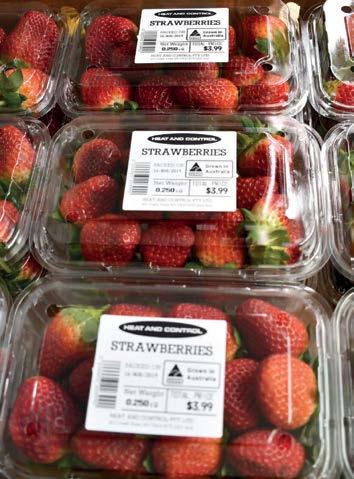

Improve inspection results with the world’s only multi-spectrum metal detector.
CEIA’s unique technology achieves the highest sensitivity to small metal fragments by applying a broad spectrum of frequencies simultaneously and continuously - with no reduction in sensitivity.
CEIA metal detectors from Heat and Control assure precise, consistent detection and rejection of metal contaminants.
Heat and Control is the exclusive distributor for CEIA in New Zealand info@heatandcontrol.com | www.heatandcontrol.com

Alternatives to plastic – not all good news Nesquik All Natural was launched in Europe in March 2019 in a paper pack with a barrier coating that is plastic-free and fully recyclable. The new pack has a shelf life of 9 months compared to 18 for the previous plastic/alufoil pack, and the price is 40-50% more expensive per kilo, partially offset by offering a smaller 168 g pack size. The new pack contain 25 servings and is expected to be used in the home well-within six months, even by "very low users" so the 50% reduction in shelf life is not considered a problem. This follows on from the launch of the Nestlé YES! Bar in the UK in 2018 using a recyclable paper wrapper in a highspeed 'flow wrap cold seal' packaging line. No Life Cycle Assessments (LCAs) have been provided to demonstrate the environmental benefits (if any) of the new packaging compared to the old. In March 2020, Gerber, a subsidiary of Nestlé, announced the launch of a first-of-its-kind, single-material pouch made from PP for its baby food products. It replaces the traditional retortable pouch made from a laminate of three materials: PET/alufoil/PP with the alufoil layer providing a moisture, light and gas barrier. Clearly the PP in the new pouch must be coated in some way to improve its barrier properties. No details have yet been released about the PP or the shelf life of foods in the new pouch. In May 2019 Unilever launched a new pack for ice cream in Italy consisting of a compostable and recyclable tub and lid made of certified PEFC paper coated with a layer of PLA, that can be recycled in the paper stream or disposed of in the organic waste stream and sent to industrial composting sites. The new pack results in a weight reduction of 23%. In March 2020 Unilever launched a 1 L ice cream pack in Finland made from paperboard coated with plant-derived LDPE. The new pack can be recycled in Finland’s carton recycling system. Again, no LCAs have been provided to demonstrate the environmental benefits of the new packs over their plastic predecessors or if there is any change in shelf life. In Australia Woolworth’s has replaced a PET tray for truss tomatoes with one made of moulded sugarcane pulp fibre. The pack uses 90% less plastic than a conventional APET clamshell punnet and combines a home-compostable sugarcane tray with printed lidding film. As well as being home-compostable, it is also recyclable in the paper stream. When discussing the sustainability of packaging, its protective function is often neglected and the focus revolves around the type and amount of material used for production. Just 1.5g of plastic film for shrink wrapping a cucumber can extend its shelf life from three to 14 days, and selling grapes in plastic bags or trays has reduced in-store wastage of grapes by 20%. Despite these obvious advantages, many consumers demand plastic-free fruit and vegetables, seemingly oblivious to the benefits. Nesquik All Natural was launched in Europe in March 2019 in a paper pack with a barrier coating that is plastic-free and fully recyclable
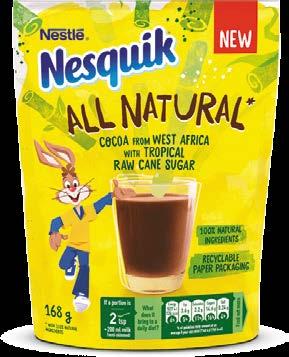
Conclusions There is no doubt that more consumer education about the meaning of ‘best before’ and ‘use by’ dates would reduce household food waste. While replacing plastic packaging with other materials might quieten the Twitterati, using an evidence-based approach to find the balance between protection of food and packaging material use could lead to an overall saving in resources, reduction in waste and environmental impacts, and increase in overall system efficiency. The food industry also has a responsibility to ensure that ‘best before’ dates are not conservative and adding the phrase ‘often good after’ could be helpful. Educating consumers what date labels mean and how to use them should be a priority in efforts to reduce food waste. The current anti-plastic campaigns and focus on recycling rather than overall sustainability risks distorting outcomes; changing the focus from recycling to overall sustainability of packaging remains a real but crucial challenge. Glossary of material acronyms PET Polyethylene terephthalate PP Polypropylene PEFC Programme for Endorsement of Forest Certification PLA Polylactic acid LDPE Low density polyethylene APET Amorphous polyethylene terephthalate
Dr. Gordon Robertson, FNZIFST is a food packaging consultant and Adjunct Professor at the University of Queensland. gordonlrobertson@gmail.com
Anne Marie Manzano 1 , Di Lu 2 , Joanne Hort 3 and Li Day 2
1. AgResearch Limited, Lincoln Research Centre, Lincoln, New Zealand 2. AgResearch Limited, Grasslands Research Centre, Palmerston North, New Zealand 3. Feast Lab and Riddet Institute, Massey University, Palmerston North, New Zealand
Introduction China is New Zealand’s (NZ) largest export market for dairy (26%, US$3.4bn (United Nations, 2017)). Despite consistent sales growth, Chinese annual per capita consumption of major dairy products remains low compared to other countries (see Table 1). China’s large population and low consumption are an opportunity for an increased presence of NZ dairy imports.
Table 1: Annual per capita volume consumption for major dairy products in China, Japan and United States. Source: (Chen, 2018)
Per capita consumption
United States Milk (litres)
14.3
36.8
51.7 Yoghurt (kg)
3.43
9.66
4.92 Cheese (kg)
0.02
1.46
6.89
Demand for fermented dairy foods such as yoghurt and cheese has grown rapidly during the last two decades (Liem et al., 2016; Wang et al., 2016). More Chinese consumers are showing interest in and acceptance of these products, even though dairy is not part of the traditional diet in large parts of the country. Rise in income, education and marketing are reported to be contributing factors to the increased prevalence (Fuller et al., 2007; Wu et al., 2020). In urban areas particularly, consumers have easy access to a wide variety of products. Innovations in fermented dairy products could promote a shift towards capturing even more value from yoghurt and cheese. In October 2017, AgResearch, the Riddet Institute and Callaghan Innovation started a new MBIE Endeavour Research Programme called “Accelerated evolution: A step-change in food fermentation”. Its goal is to create a step-change in how premium NZ fermented foods are developed. Using accelerated microbial strain improvement methods and emerging techniques in phenomics (the physical and biochemical traits that comprise phenotypes), we can fast-track the evolution of a cohort of food grade microbial strains and pressure them to produce metabolites during fermentation that affect the sensory and physical attributes of foods, such as novel flavours and textures. This ‘pipeline’ of methods will facilitate a new approach to product design and lead to a generation of clean-label fermented food products. The programme’s industry partners are supporting it with aligned projects. They are interested in developing fermented foods with differentiated flavour and texture profiles, to appeal to Asian export markets such as China. The initial stage of these projects was to evaluate consumers’ preferences for fermented food products.
Methods An online survey was designed to evaluate Chinese consumer preference and familiarity with fermented dairy foods, particularly drinking yoghurts and cheeses. The survey also measured their purchasing and consumption habits, and the importance of different product attributes. The survey questions were prepared in consultation with Miraka (a NZ dairy company) and COFCO Nutrition Health and Research Institute (NHRI) in China. Collaboration with scientists from the COFCO NHRI Consumer and Sensory Science group ensured that the questions were accurately translated into Chinese and could be understood by Chinese consumers within their cultural context. Five hundred online participants (250 from the northern city Beijing and 250 from the south-east city Shanghai) were recruited by COFCO using their online platform and their panel database of consumers. Potential participants were asked to complete the survey if they met the following screening criteria: • consumed fermented dairy products more often than monthly, and; • knew something about NZ. The survey began with a set of demographic questions. Respondents
were then asked to describe their average monthly purchasing habits of yoghurt and cheese products, as well as their consumption habits, with a combination of multiple-choice questions, verbal frequency scale matrix questions and written responses. These questions were followed by a set of Likert Scale matrix questions, asking respondents to rate the importance of different product attributes when shopping for a yoghurt or cheese product. A forced ranking scale question was also posed, to understand Chinese consumers’ concerns with buying fermented dairy products. Respondents were asked to select ten statements from a set of concerns that might prevent them from purchasing more fermented dairy products, and to rank these statements from highest (1) to lowest (10) severity. Survey data were analysed using frequency tables, in order to see the distribution of results clearly. These percentages were graphed using stacked bar charts, to visualise which attributes had the greatest proportion of “positive” responses, such as always, very important, and highest ranked.
Table 2: Demographic profile of the total sample (n=500)
CITY Percent (100%) LIVING SITUATION
Beijing
Shanghai
GENDER
Male
Female
AGE
18 – 24
25 – 34 50
50
50
50
2
30 Alone
Spouse
Children
Parents / in-laws
Grandparents / in-laws
EDUCATION
Primary school
Junior high school
High school Percent (100%)
(multiple selection)
5
89
80
14
0
0
0
5
Results and discussion Table 2 summarises the demographic data collected for all respondents, who were predominantly between 25 – 54 years old. Most were married with children and university educated. For approximately half (44%), their family’s gross annual income sat near or above China’s national average of CNY154,000 (around NZ$34,000 ) (Sohu, 2017). Purchasing and consumption habits Yoghurt and cheese are purchased four times per month by 45% and 36% of respondents, respectively, and on average, respondents spend CNY85 (NZ$19) on yoghurt and CNY129 (NZ$29) on cheese per month. When asked to select which products they usually purchase, for yoghurt, drinking yoghurt was selected by most respondents, with ambient (79%) being more popular than chilled (66%). Spoonable yoghurt was selected by over half of the respondents, and ambient (62%) was also the more popular choice than chilled (57%). For cheese, processed cheese and particularly cream cheese (66%) was more popular amongst respondents than unprocessed (natural) cheese (39%). Yoghurt is regularly consumed two to five times per week by half of the respondents (48%), and more than once a day by a third (34%) of respondents. Cheese is consumed once a week by 41% of respondents. This reflects the consistent growth of yoghurt sales in China, maintaining an annual retail sales growth of over 20% since 2014 (Chen, 2018), driven by the fastest-growing segment, ambient drinking yoghurt, with sales up 13% in 2019 (Euromonitor, 2019). However, as the rate of growth slows due to increasing maturity, this may pose challenges with introducing a competitive offer amongst the clear consumer habits and preferences being formed. Meanwhile, these responses also reflect the growth of the much smaller emerging cheese segment in China. Cheese sales reached CNY6.5 billion in 2019, compared with yoghurt sales of CNY149.3 billion (Euromonitor, 2019), and saw a growth rate of 15-25% from 2015-2017 (Chen, 2018). This has largely been driven by growth in processed cheese snacks, in response to the increasingly busy nature of modern urban living. However, unprocessed cheese is still seen as a Western-style product, and its strong flavour can be unattractive for 35 – 44 18 Vocational 13 45 – 54 44 Bachelor’s degree 71 55 – 64 6 Graduate degree 11 65+ 0
FAMILY INCOME (CNY) (gross, annual) FAMILY COMPOSITION Less than 50,000 0 Single, no children 6 50,000 – 69,999 0 Single, with children 2 70,000 – 89,999 3 Couple, no children 2 90,000 – 109,999 6 Couple, with children 90 110,000 – 129,999 22 130,000 – 149,999 24 150,000 and above 44
Yoghurt - Which attributes are the most important to you when shopping for a fermented dairy product?
many Chinese consumers who are unfamiliar with it. In general, there is still a lack of awareness of cheese and its potential uses, and there is a strong opportunity to increase exposure to cheese, to lead to greater consumer familiarity. Product preferences and concerns Figure 1. lists respondents’ ratings of the desirability of different product attributes when shopping for yoghurt and cheese. The results suggest that “quality “and “freshness” are most important. 71% and 68% of respondents rated the quality certificate to be a very important attribute, followed by freshness (68% and 67%) and the manufacturing date and expiry date (65% and 67%). “Freshness” may have been perceived by respondents as strictly a concept of time rather than closeness to natural state or non-preserved, which may be linked with the cultural importance placed on the manufacturing and expiry dates. This is consistent with concerns for freshness described by Zhong, Carng, & Zeng (2019), as meaning immediacy and localness for Chinese consumers. As the date of domestic products will always be “fresher” than imported products, this perception may limit exporters’ competitiveness with domestically manufactured products. Tables 3a and 3b list respondents’ highest ranked concerns, preventing them from purchasing more yoghurt and cheese. Over a third of respondents (35%) ranked the use of artificial preservatives / additives as one of their top three concerns, followed by the products being unhealthy, particularly its high fat content. Respondents were also worried about food safety, such as spoilage and fear of disease / contamination. Taste, as expected, is still an important factor, with 24% and 21% of respondents ranking not liking the taste as one of their main reasons for not purchasing more products. Overall, Chinese consumers are looking for products they perceive to be natural, premium (organic, sustainable) and healthy, while still being tasty. This is consistent with market research results which suggest health-related factors are the main areas consumers are willing to pay a premium for, and claims such as low fat or fat free, and no-additives, are most valuable (Chen, 2018). Figure 1b: Responses to "Which attributes are the most important to you when shopping for a cheese product?" (n=500), % of total sample Table 3a: Responses to "What prevents you from purchasing more yoghurt products?" CHEESE (ranked 1-3, top 7, % of total sample) It contains artificial preservatives/additives 35 It has high fat content 26 Fear of disease/contamination 25 Unhealthy 25 Spoilage 24 YOGHURT (ranked 1-3, top 7, % of total sample) It contains artificial preservatives/additives 35 Unhealthy 32 Spoilage 27 Fear of disease/ contamination 25 Do not like taste 24 Page 2 of 2 Figure 1: Responses to "Which attributes are the most important to you when shopping for a fermented dairy product?" (n=500), % of total sample Quality certificate Manufacturing date and expiry date Freshness Health content Nutritional value Organic, free range, natural Brand / word-of mouth Flavour, texture Environmental effects of production Country of production origin Variety, new products/new flavours Social responsibility of production Sales price Packaging design/small packs/convenient % of total sample 0% 20% 40% 60% 80% 100% Cheese - Which attributes are the most important to you when shopping for a fermented dairy product? e Very important e Somewhat important e Neutral e Not so important e Not at all important e Don't know 68% 67% 67% 57% 57% 45% 41% 40% 36% 28% 28% 26% 22% 19% Page 2 of 2 Figure 1: Responses to "Which attributes are the most important to you when shopping for a fermented dairy product?" (n=500), % of total sample % of total sample 0% 20% 40% 60% 80% 100% Quality certificate Freshness Manufacturing date and expiry date Health content Nutritional value Organic, free range, natural Brand / word-of mouth Flavour, texture Environmental effects of production Variety, new products/new flavours Country of production origin Social responsibility of production Sales price Packaging design/small packs/convenient e Very important e Somewhat important e Neutral e Not so important e Not at all important e Don't know 68% 43% 31% 65% 47% 36% 30% 56% 56% 44% 32% 20% 20% 71% Figure 1a: Responses to "Which attributes are the most important to you when shopping for a yoghurt product?" (n=500), % of total sample
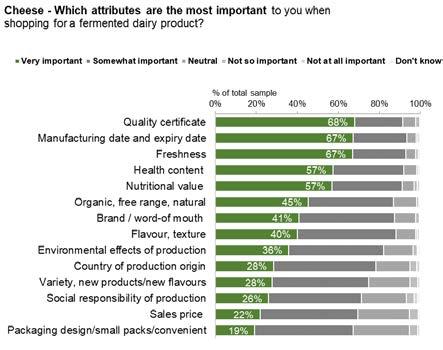
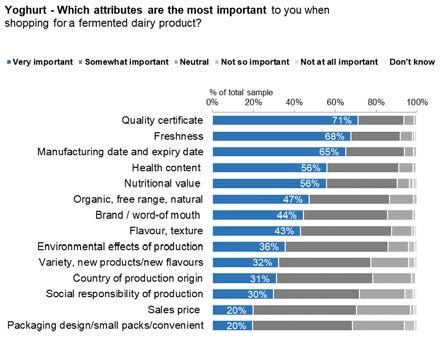
Figure 2 lists respondents’ ratings of the importance of various attributes in a hypothetical ideal yoghurt product. The attributes rated very important by most respondents reflected their major concern with the use of artificial preservatives/additives in fermented dairy products. Around half of respondents selected it was very important that their ideal product did not contain “bad” artificial ingredients such as preservatives (61%), additives (56%), artificial colours (53%) and gelatine (42%). Gelatine may have been noted as an added thickener and associated with the yoghurt achieving its texture artificially. Whereas being fermented (33%) may have been linked with the yoghurt achieving its texture naturally. Therefore, respondents described their ideal yoghurt product as: • processed “naturally,” e.g. has reduced sugar content (32%), which may have been related more with the use of artificial sweeteners (as opposed to health concerns); • healthy, e.g. has added probiotic bacteria (43%), which may have been recognised for their natural health benefits as “good” bacteria; and • produced with premium ingredients, e.g. organic (43%) and sustainable milk (36%), where the terms “organic” and “sustainable,” may have been perceived as premium, “green” attributes, and associated with a high-quality product. The sensory property most important in their ideal yoghurt was its texture (42%). This is in line with market research which reports that textural descriptions can help to extend consumption occasions and enhance the indulgent appeal of yoghurt, such as thick textures, which are often associated with being premium (Waikl, 2019). However, this question offered a limited list of sensory properties for selection and did not include taste. As surveys require concise questions and brief responses, focus groups, which provide the time and discussion required for participants to offer their own sensory descriptions, would reveal more regarding consumers’ ideal sensory attributes. References Chen, S. (2018, May 14). China's yoghurt and cheese markets experience steady high value retail sales growth. Retrieved from Mintel: https://www. mintel.com/press-centre/food-and-drink/chinas-yoghurt-and-cheesemarkets-experience-steady-high-value-retail-sales-growth Euromonitor. (2019). Passport: Cheese in China. Euromonitor. (2019). Passport: Yoghurt and sour milk products in China. Fuller, F., Beghin, J., & Rozelle, S. (2007). Consumption of dairy products in urban China: results from Beijing, Shangai and Guangzhou. Australian Journal of Agricultural and Resource Economics, 51(4), 459-474. doi:10.1111/j.1467-8489.2007.00379.x Figure 2: Responses to "What does your ideal yoghurt look like? (n=500), % of total sample Figure 3: Responses to "What does your ideal yoghurt look like? (n=500), % of total sample e Very important e Somewhat important e Neutral e Not so important e Not at all important e Don't know % of total sample 0% 10% 20% 30% 40% 50% 60% 70% 80% 90% 100% Preservative free No additives No artificial colours Number of added probiotic bacteria Made with organic milk Without gelatine Texture Made with milk from sustainable farms Fermented Reduced sugar content Added calcium Reduced fat Added protein Added fibre No fat Lactose free No cane sugar Reduced lactose Sourness GE Free Full cream Includes cereal Includes fruit bits Fruit flavour, no bits High level of sweetness 61% 56% 53% 43% 43% 42% 42% 36% 33% 32% 32% 31% 28% 28% 27% 26% 25% 25% 23% 22% 21% 20% 18% 17% 15%
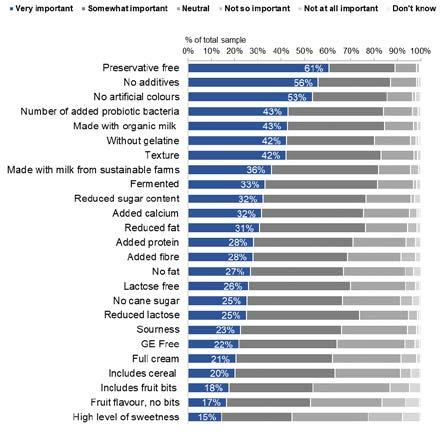
Conclusion With the stable growth in China’s dairy market over recent years, Chinese consumers attracted to the health and nutrition benefits of dairy products, have begun to establish a consumption habit for yoghurt products and an increasing familiarity with cheese products. With freshness top of mind for most consumers of drinking yoghurts and cheese, overseas brands will need to find solutions to address consumers concerns for immediacy and localness, to compete with domestic brands. Focusing on natural processing will add to the health appeal of fermented dairy products and create premium options. Ensuring the sensory properties match with Chinese consumer expectations will also be key, while innovating in textures and format will add further occasions for increasing consumers’ consumption of yoghurt products and exposure to cheese products. Acknowledgement We thank our industry partner Miraka, particularly Dr Brendan Haigh, and the staff of COFCO for their input into the design and implementation of this survey, particularly Dr Cairui Qu and Dr Fei Guo. Liem, D., Bolhuis, D., Hu, X., & Keast, R. (2016). Short communication: Influence of labelling on Australian and Chinese consumers’ liking of milk with short (pasteurized) and long (UHT) shelf life. Journal of Dairy Science, 99(3), 1747-1754. doi:10.3168/jds.2015-10516 Sohu. (2017, December 27). 2017 China's average annual income of working families announced, see if your family has achieved the standard? Retrieved from Sohu: https://www.sohu.com/a/213066782_222858 United Nations. (2017). UN comtrade database. Retrieved from http:// comtrade.un.org Waikl, A. (2019). A year of innovation in yoghurt, 2019. Mintel. Wang, Q., Hansen, J., & Xu, F. (2016). China’s emerging dairy markets and potential impacts. 2016 Annual Meeting, July 31-August 2 (p. 13). Boston, Massachusetts: Agricultural & Applied Economics Association. doi:10.22004/ag.econ.235833 Wu, X., Hu, B., & Xiong, J. (2020). Understanding Heterogeneous Consumer Preferences in Chinese Milk Markets: A Latent Class Approach. Journal of Agricultural Economics, 71(1), 184-198. doi:10.1111/1477-9552.12327 Zhong, S., Carng, M., & Zeng, G. (2019). Constructing freshness: the vitality of wet markets in urban China. Agric Hum Values. doi:10.1007/s10460-019- 09987-2 Page 4 of 4
Kombucha Today
Anthony N Mutukumira 1 , Kay Rutherfurd-Markwick 2 , Xiaolei Wang 1 and Richard Archer 1,
1 . School of Food and Advanced Technology,
2 . School of Health Sciences, Massey University University,
This is the second of three articles on kombucha and its place in the beverage industry today. The three articles are intended to help manufacturers understand some of the issues and problems around kombucha production and storage with a view to helping to maintain the long-term credibility of kombucha, across the industry. In our first article we explained the range of yeast and bacteria that are contained in the SCOBY starter and the waves of organisms and metabolism which dominate as the oxygen levels, redox potentials and pH all decrease during fermentation. Sugar is metabolised by the micro-organisms and organic acids and flavoursome compounds are produced. Ethanol is also produced and then may be partially converted to acetic acid (Figure 1). Bacterial cellulose is elaborated and adds another layer to the SCOBY. Dark pigments in the tea lighten and carbon dioxide is produced in several phases which carbonates the beverage.
What is kombucha? Kombucha is a slightly sweet, mildly acidic, slightly alcoholic and sparkling beverage consumed around the world. It is made by fermentation of sugar-sweetened cold tea by a symbiotic starter culture of yeast and bacteria termed a SCOBY. For centuries, kombucha was
Tea fungus

Fermented tea broth
Kombucha tea fungus and liquid broth
Watch-outs for those producing Kombucha products
• Labelling. These include generic labelling requirements, (such as name and address of supplier, name of the food, statement of ingredients and date marketing, and nutrition information) and other labelling requirements associated with both nonalcoholic and alcoholic beverages. Alcohol content. %ABV governs which labelling requirement apply. Testing procedures and equipment used to assess alcohol content should be validated to ensure that suitable testing methods are being used by skilled operators. Alcohol needs to be controlled across the entire shelf life and considered when determining the products’ shelf lives. Claims not permitted under FSANZ 1.2.7 Nutrition content, health & related claims. Of note, nutrition content or health claims are not permitted on beverages containing more than 1.15% alcohol by volume. Claims made under FSANZ 1.2.7, substantiation is to be held by the company making the claim Therapeutic claims (referring to the prevention/diagnosis/cure/ alleviation of a disease, disorder or condition) are not permitted on foods
• Probiotics, FSANZ 1.2.7 Nutrition, health & related claims allow nutrient claims for probiotics subject to the following: • the substance and its amount must be declared in or near the NIP • qualifying with adjectives such as high or low are not permitted Ingredients considered to be non-traditional food for Australia and New Zealand and would need to consider section 1.5.1 Novel Foods. Look at the FSANZ Novel Foods Reference Group or the Advisory Committee on Novel Foods
a cottage product made and consumed locally, not packaged and distributed. Today, different flavours of kombucha are made in small industrial fermenters, bottled and sold worldwide through various channels. However, some manufacturers have struggled to maintain the ethanol below safe levels over the shelf life of their kombucha product, even if it was under the legal limit when it left the brewery. And some manufacturers seem so convinced of kombucha’s recuperative powers that their label claims are more imaginative than informative.
Industrial production of kombucha Commercial kombucha producers face different challenges to those experienced by the traditional home brewer. Large-scale producers need a profit margin and the fermenter and production time are major costs to the business. Thus, a short and efficient fermentation process is desirable for the business. However, a shorter process is likely to compromise the overall quality of the final beverage and may result in the retention of high ethanol levels. A manufacturer may use a non-purpose built, large, deep vessel for the fermentation, rather than the traditional small jar which is usually covered by a clean micro-porous cloth for natural aeration. A large vessel is likely to have a relatively small opening or may be equipped with a fermentation lock to prevent contamination. It is also unlikely to be agitated, and if it is the agitation will be gentle so as not to break up the SCOBY. In short, most large-scale manufacturers have systems that are not optimised for oxygen uptake which translates into a (fermentation) process that is not optimised for conversion of ethanol to acetic and gluconic acids. These two factors predispose kombucha made on large scale for profit to retaining higher residual sugar, higher ethanol and lower acid contents than a longer duration home-fermented kombucha might typically yield.
Product stability challenges during distribution When kombucha is kept in an open container, there is potential for some of the ethanol to be oxidised to acetic acid. However this possibility is inhibited by bottling, which prevents oxygen ingress, and since ethanol is stable, the levels will not go down during distribution. Commercial kombucha manufacturers must sell product, and since cellar door sales are unlikely to be high enough, the manufacturer needs to distribute through supermarkets, the route trade, farmers’ markets or internet sales. Under these circumstances, most manufacturers lose control of the conditions under which the kombucha is stored. Is it really stored and transported at a chill temperature at all times? If shelf life was the only parameter impacted by storage temperature, this issue would only impact profit. However, kombucha is a very low alcohol product sold to people expecting it be just that; and for some people too much alcohol is a safety issue. If beverages contain alcohol in excess of 1.15%ABV (NZ) or 0.5%ABV (depending on the jurisdiction in Australia) they need to be declared as an alcoholic beverage, and licensing requirements including excise duty would apply. Hence the kombucha manufacturer can unwittingly be evading taxes, which may pose a threat to their on-going business. As long as live yeast and residual sugar remain in the final kombucha that leaves the brewery, there is the potential for the drink to form more ethanol. One gram of residual sugar in a bottle can make up to 0.5 g of ethanol (i.e. each 1.0 g/100 mL of residual sugar can convert to up to an additional 0.5 %ABV over time). Manufacturers then have three choices to control this: • They can sell the product with zero shelf life; i.e. only sell the product for consumption on-site • They could pasteurise the contents of the bottle to kill the yeast, along with most of the organisms which they might consider to be probiotic and therefore of health benefit • They could ensure that the bottle is kept very well refrigerated for the duration of its shelf life. The safest approach, however, would be to ensure that there is not enough residual sugar in a bottle of kombucha to cause the ethanol level to rise above the level claimed on the label.
Regulatory and food safety issues Regulations aim to help keep consumers safe and accurately informed via truth in labelling. All fermented beverages for sale in New Zealand must adhere to the relevant regulations in the Australia New Zealand Food Standards Code, the NZ Food Act 2016, the Fair-Trading Act, the Advertising Standards Code and, depending on the alcohol content of the products, the Liquor Licensing Acts. In New Zealand, the Ministry for Primary Industries (MPI) is the agency with responsibility to interpret and enforce the standards code and the NZ Food Act. MPI can direct any non-compliant company to change its labelling and, if deemed necessary, can prosecute the company. The Ministry is particularly alert to non-compliant kombucha currently. The fermented beverage industry ‘straddles’ both the food and the alcohol industries. Producers need to determine if their products meet the definition of an alcoholic beverage, or the definition of a food, and ensure compliance with the most appropriate regulations. The public health and safety risks of alcohol hidden in ‘non-alcoholic’ beverages is of concern to governments and regulators. A Consumer article published in June 2019 stated that “due to the presence of alcohol and caffeine, the beverage is unsuitable for children or pregnant and breastfeeding women.” Statements such as this are based on Consumer and others having measured ethanol levels of over 2.5% in certain kombucha products which claim to have negligible alcohol and numerous unsubstantiated health benefits. Instances such as this may lead to negative health consequences, but more importantly are potentially damaging to the kombucha industry itself as it leads to a general lack of trust in all kombucha products. When considering exporting kombucha consideration to the jurisdiction should be applied. The Food Standards Code provides a good summary of alcohol labelling requirements in its appendix to Standard 2.7.1 (Table 1). Nutrition content, health and related claims are regulated in the Food Standards Code under Standard 1.2.7. This provides guidance on the types of health claim that can be made and under what circumstances the various regulations apply. Nutrition content claims require that certain criteria are met in order to justify the claimed benefit. It is important that relevant and accurate testing is carried out to determine label content. General level health claims must be based on scientifically substantiated food health relationships, and high-level health claims must be founded on pre-approved relationships such as ‘low in saturated fatty acids and reduced blood cholesterol’.
Health benefits of kombucha The popularity of kombucha may be attributed at least in part to its proposed health benefits which include; energising and detoxifying attributes, alleviating digestive problems, cancer prevention, alleviation of inflammation and arthritis, and enhancement of immunity although evidence from clinical trials to support these purported benefits is lacking. Several studies have reported that tea kombucha has high antioxidant activity which increases as fermentation progresses, potentially due to the generation of low-molecularweight substances (ascorbic acid and D-saccharic acid -1,4- lactone) and structural modifications of tea polyphenols by enzymes produced by yeast and bacteria during fermentation. Certain health benefits from kombucha consumption may be attributed to its antioxidant properties due to the presence of polyphenols such as catechins from the tea used as the raw material for kombucha fermentation.
Table 1: Labelling requirements under Standard 2.7.1
Statement of Alcohol Content
<0.5% ABV ≥ 0.5% to ≥ 1.15% ABV >1.15% ABV 2.7.1-3(1b) (Applies to alcoholic beverages) The statement of alcohol content must be expressed in words to the effect ‘CONTAINS NO MORE THAN X% ALCOHOL BY VOLUME’ 2.7.1-3(1a) (Applies to ‘food including alcoholic beverages’) The statement of alcohol content must be expressed in one of either: mL/100g mL/100ml % ALCOHOL BY VOLUME 2.7.1-3(1c) (Applies to ‘beverages’) The statement of alcohol content must be expressed in words to the effect ‘CONTAINS NO MORE THAN X% ALCOHOL BY VOLUME’ Statement of the number of standard drinks >0.5% ABV 2.7.1-4(1) (Applies to ‘beverages’) Must include a statement of the approximate number of standard drinks
Kombucha tea has also been shown to exhibit antimicrobial activity against a range of pathogenic microorganisms (e.g. Aeromonas hydrophila, Enterobacter cloacae, Salmonella typhimurium, Helicobacter pylori, Staphylococcus aureus, Yersinia enterolitica, Escherichia coli, Campylobacter jejuni, Shigella sonnei, Samonella enteritidis, and Candida albicans). This antimicrobial effect is mainly due to the presence of organic acids, particularly acetic acid, in the fermented kombucha. However, antimicrobial activity has been observed after thermal denaturation or pH neutralisation of the kombucha, suggesting the presence of antimicrobial compounds other than acetic acid. The Lactobacillus spp. in kombucha can secrete bacteriocins and plantaricin; which are small thermally stable peptides capable of inhibiting the growth of Gram-positive and Gram-negative pathogens under acidic conditions. However, thorough investigations of lactic acid bacteria species in kombucha are still lacking.
Many commercial kombuchas claim to contain probiotics. According to the FAO/WHO: “probiotics are live microorganisms promoted with claims that they provide health benefits when consumed, generally by improving or restoring the gut flora”. To provide health benefits, those live organisms should be higher than 10 6 at the time of consumption and must at least transiently colonise the human gut. To date only relatively few micro-organisms have been proven to confer probiotic benefits and even fewer products have been shown to contain relevant probiotics in sufficient quantities to gain regulatory approval for a probiotic health claim. The presence of a few thousand unidentified live, microorganisms does not render the product as probiotic. Hence a number of manufacturers may be at risk if they are making such health claims. and alkaloids, which may contribute to the health-promoting effects (antioxidant and antibacterial activities). Moreover, fermentation products, such as acetic acid, gluconic acid, ethanol, glycerol and glucose play important roles in the sensory attributes of kombucha. However, the constituents of the final products of kombucha may be significantly affected by fermentation conditions and conditions experienced during distribution, thereby compromising their health benefits and overall quality. The kombucha sector of the New Zealand beverage market is possibly the most exciting and buzzy niche. However, some manufacturers do not yet have their manufacturing and supply chain under adequate control to remain within regulatory bounds. Kombucha, inadequately controlled, can contain levels of alcohol dangerous to some. The industry has already lost some manufacturers as a result of this. If we want the kombucha industry to continue to thrive in New Zealand we would like to avoid loss of others. For more information and for the full reference list email: a.n.mutukumira@massey.ac.nz Acknowledgment: Labelling advice was received from Brenda McKellow, who is an experienced beverage consultant, and can be reached at email: brendamckellow@xtra.co.nz The third article in this series will cover methods of, and pitfalls in kombucha analysis.
Conclusion Kombucha as a traditional health-promoting fermented beverage, which is prepared with tea, sugar and a symbiotic consortium of yeast and bacteria. The fermented beverage contains a large number of nutrients from tea, such as polyphenols, minerals, amino acids
Dr Tony Mutukumira and Associate Professor Kay RutherfurdMarkwick are working on kombucha at the Food Fermentations Laboratory, Massey University, Auckland Campus. They have generated some microbiological and chemical analytical methods for the analysis of kombucha to assist producers.
A regular round-up of news and opinion from the Oils and Fats Group of the New Zealand Institute of Chemistry. Oils and Fats News

Laurence Eyres, FNZIFST
CO VID -19 As the disease begins to dominate all aspects of our day-to-day lives it’s hard to envisage that one day we will return to normal and get back to other issues. Whilst not giving medical advice I have been giving some thought as to how we can support our natural resistance to this type of RNA virus. There are several well documented articles in the literature that point to certain natural ingredients being of benefit in prevention or alleviating symptoms of respiratory ailments. These are as follows: Zinc: Several countries, including New Zealand, are deficient in zinc due to its low levels in the soil. Taking a supplement containing 15 mg per day may have some benefit. Good thinking and advice from Dr. Bob Corish. https://journals.plos.org/plospathogens/article?id=10.1371/journal. ppat.1001176 Vitamin D: As we are less exposed to sunlight in modern times it would be advisable to take a Vitamin D3 supplement. Low levels of this Vitamin leave us susceptible to infection. Antioxidants from blueberries and blackcurrants are well known defence ingredients. Other powerful antioxidants include polyphenols such as Hydroxytyrosol from quality virgin olive oil. They have proven to be anti-inflammatory. We can always stick to Manuka honey the old stand-by, if we can afford it. The other lipid product of benefit is of course soap. Dr. Bronner’s liquid soaps are concentrated and contain essential oils such as peppermint and lavender. www.drbronner.com, Your online pharmacy may have stocks and be able to deliver.
Other health benefits of Virgin olive oil As people age, the more their brains could benefit from the action of an important component in olive oil. New research has revealed the deeper effects of hydroxytyrosol (HTyr): Not only does it protect brain functions from ageing, but it may even restore the vitality of brain neurons, and multiply them. The antioxidant activity of hydroxytyrosol activates a sort of cleaning treatment for nervous cells. Italian scientists at the National Research Centre (CNR) investigated how hydroxytyrosol works in those portions of the brain that generate new neurons throughout life. They discovered that HTyr impacts brain activities far beyond its well-known neuroprotective effects. Researchers at the CNR Biochemistry and Cellular biology Lab (CNRIbbc) were able to show how the administration of the compound in the elderly may reverse neuronal ageing, combining the protection of the active neurons and the generation of new ones. “Hydroxytyrosol oral consumption by young and older animals shows, within a month, not only how the new neurons generated by the brain in that timeframe are protected, but it also hints how in older animals it stimulates the multiplication of stem cells”
CBD-a complex mixture of chemical species This is another emerging natural product that may have some benefit in our armoury of weapons against infection. A new study of the first 400 patients in Aotearoa New Zealand assessed for medical cannabis suggests potential benefits for thousands of people beyond currently recognised uses. The study, a collaboration between the University of Auckland and GP Dr Graham Gulbransen, who opened the first medical cannabis clinic in Aotearoa New Zealand, examined the records of 400 patients assessed for treatment at Dr Gulbransen’s west Auckland clinic "Cannabis Care". Products containing cannabidiol (CBD oil), an active compound derived from the cannabis plant which does not give people a ‘high’, were legalised for prescription by doctors in New Zealand in 2017. CBD is FDA-approved for the treatment of two childhood seizure disorders, but early evidence suggests it could also help treat anxiety and chronic pain and may reduce psychotic symptoms of schizophrenia. Due to a lack of large-scale, controlled studies in humans, there are no prescribing guidelines. The new study found that CBD oil taken for four weeks significantly improved the self-reported quality of life most for patients living with non-cancer chronic pain and anxiety-related mental health conditions. Patients with cancer or neurological symptoms also experienced improved quality of life, but to a lesser degree. Because symptom assessments were subjective, it is not possible to determine how much of this was due to placebo effect. “Our findings show that CBD is well-tolerated in most patients and can markedly ease symptoms in a range of hard-to-treat conditions, and that there are people keen to access this and self-fund the medication (about $300 per month),” says Professor Bruce Arroll, senior author in the study and head of the Department of General Practice and Primary Healthcare at the University of Auckland.

“The study has limitations due to drop-out and other factors, but the findings are consistent with other evidence and underline the need for more research to allow us to fully realise the therapeutic potential of medical cannabis.” N.B. only GP’s can currently prescribe CBD.
Lipid mediators - the ethanolamides The resolution of neuroinflammation is a process that allows for inflamed tissues to return to homeostasis. In this process the important players are represented by lipid mediators. Among the naturally occurring lipid signalling molecules, a prominent role is played by the N-acylethanolamines, namely N-arachidonoylethanolamide and its congener, palmitoylethanolamide or PEA. PEA possesses a powerful neuroprotective and anti-inflammatory power with no known adverse side effects. The discovery of the cannabis receptors and the nuclear peroxisome proliferator-activated receptors was the beginning of a completely new understanding of many important homeostatic physiological mechanisms in the human body. These discoveries were necessary for us to understand the analgesic and anti-inflammatory activity of PEA, a body’s natural fatty amide. PEA is a nutrient known for more than 50 years. PEA is synthesised and metabolised in animal cells via several enzymes and has a multitude of physiologic functions related to metabolic homeostasis. PEA was identified in the 1950s as a therapeutic principle with potent anti-inflammatory properties. Since 1975, its analgesic properties have been noted and explored in a variety of chronic pain states. Since 2008, PEA has been available as a nutraceutical. A literature search on PEA meanwhile has yielded over 350 papers, all referenced in PubMed, describing the physiologic properties of this endogenous modulator and its pharmacologic and therapeutic profile Step by step emergence of insight These four periods are: • 1954–1979, when PEA was found to be an nonspecific immunologic resistance enhancer, with anti-inflammatory properties and anti-influenza and anti-common cold indications • 1980–1992, “a silent gap”, with unanswered questions related to the mechanism of action of PEA.
• 1992–1998, due to the work of Nobel prize winner, LeviMontalcini, PEA was recognised as a mast cell modulator, and then (wrongly as it appeared later) as a CB2 cannabinoid agonist. • 1998 onwards, when PEA was identified as having high affinity for peroxisome proliferator-activated receptor alpha (PPAR-α), transient receptor potential vanilloid type 1, and the GRP 55 receptor. It has also been found to be a nonspecific immune enhancer in respiratory tract infections After commercialisation of PEA in the early 1970s, six clinical studies of the effects of Impulsin in the treatment of respiratory tract infections were published. In 1974, Masek et al published the results of two double blind, controlled trials including 1,345 healthy subjects, of which 41 failed to complete the trial.* The goal of these trials was to evaluate the efficacy of PEA in upper respiratory tract infections. The subjects were to take 600 mg PEA three times daily or placebo for 12 days. In the first trial, 468 employees of the Skoda car factory, all suffering from influenza-like symptoms, such as fever, headache, sore throat, myalgia, nasal discharge, productive or dry cough, malaise, and fatigue were randomised to receive PEA 600 mg or placebo three times daily for 2 weeks. The second trial, which was prophylactic, included 918 volunteers aged 16–18 years and living in an army unit. Treatment was identical to that in the first trial for the first 2 weeks, after which a continuation dose of PEA 600 mg or placebo was administered once daily in a double-blind fashion. *Journal of Pain Research 2013:6 N.B. The Oils and Fats Group have sponsored a fourth year Food Tech. project at Massey University on delivery systems for PEA
WCO F 2020 Sydney Despite the lower than expected attendance at this conference in Sydney, the participants enjoyed a stimulating and informative conference with specialist courses on frying, and nutrition held concurrently. There were interesting papers from New Zealand presenters who included Professor Marie Wong speaking on why Extra Virgin olive oil is an excellent cooking oil. Allan Woolf describing Plant and Food avocado work in Kenya. Dr Mikhail Vyssotsky spoke on NMR of lipids, Geoff Webster on rice bran oil, Matt Miller on near IR of marine lipids and Glen Neal gave an update on hemp oil. A jolly fatty time was had by all.
Earle Travel Fellowship in Technology 2019 Report - Daniel Burgess
Daniel Burgess
Every now and then life will offer an opportunity that sounds truly amazing, and when I was fortunate enough to learn of the 2019 Earle Travel Fellowship, I knew this was one I could not let pass me by. The Fellowship is intended to allow a recently graduated engineer or food technologist to travel overseas and increase their knowledge and skill. Luck was certainly on my side as to my absolute thrill I was awarded the Fellowship!
Objectives My objectives to start with were to meet with experts, attend the Product Development and Management Association (PDMA) Conference to learn about the latest in best practice New Product Development (NPD), attend the AI & Big Data Expo to get exposure to the state-ofthe-art in this rapidly growing industry, and visit key industries in order to get an update on practices and ways that successful companies approach problem solving. The following brief report shows that in the 3 intense weeks in the USA in November 2019 I achieved much more than these and have gained lasting benefits and made valuable contacts. PDMA Conference PDMA is a global community of professionals made up of product development and management practitioners and academics. The PDMA 2019 Annual Conference and Research Forum was held in Orlando, Florida. The 2019 theme was Disruption by Design and the 4-day event included presentations on the latest research and papers for the Journal of Product Innovation Management (JPIM), a 1-day workshop on Design Thinking, 2 days of presentations by speakers on tracks of Business-To-Business (B2B), Business-To-Consumer (B2C), Services, and Software and AI including many motivating keynote speakers. There were ample opportunities for networking including several receptions, one of which was held at Walt Disney’s EPCOT Theme Park. I have come away from the PDMA conference with a treasure trove of new information and resources, as well as connections to many professionals. The Design Thinking 1-day Workshop was an inspiring and knowledgepacked way to learn tools to help place the customer at the heart of the design process. FABTECH FABTECH is described as North America's Largest Metal Forming, Fabricating, Welding and Finishing Event, and in 2019 it was held at the McCormick Convention Centre in Chicago, Illinois. The expo was a massive event, far bigger than anything I have seen in Auckland, with over 1800 exhibitors and 40,000 attendees. Highlights for me were seeing the state-of-the-art technologies on display for Additive Manufacturing, and Robotics and Industrial Automation. I have come away from the FABTECH expo inspired with solutions that could be applied in manufacturing, as well as contacts and resources. The size of the FABTECH expo was breath-taking. Shown here is a panoramic view from the centre of one of the three exhibition buildings. AI and Big Data Expo The AI & Big Data Expo and IoT Expo was held over 2 days at the Santa Clara Convention Centre in Santa Clara, California. This was a moderate sized event (350 exhibitors, 500 speakers, 13,000 attendees) which held multiple conference tracks on subjects such as AI Technology Solutions, Big Data Business Solutions, Data Analytics for AI & IoT, and Enterprise AI. The Internet of Things (IoT) Expo was held at the same location, and I found this particularly valuable, being able to connect with companies who build solutions for IoT and electronics. One nice thing about the AI & Big Data Expo is because I had purchased the premium pass I was provided audio recordings and presentation files for all the speakers, so if any of these subjects are of interest to colleagues at my company or PDMA-NZ members, I am able to share these easily. I also had the opportunity to visit some companies including Tomorrow Lab, a small but leading Product Design firm based in New York. Through contacts I was able to tour one of the Nvidia offices in Santa Clara, California (Nvidia is a graphics processing chip manufacturer), and toured the Facebook office in Austin, Texas. This trip was a wonderful mind-expanding experience that has given me a wealth of new knowledge and insights, so I would like to express my utmost appreciation to Professors (retd) Dick and Mary Earle for the Fellowship grant, along with the selection committee for the opportunity. I strongly recommend that other engineering/tech graduates apply for this awesome grant.
Applications invited for Richard & Mary Earle Travel Fellowship Award 2020 The Earle Travel Fellowship is an annual grant of up to $15,000 that helps fund overseas travel for young Engineers & Food Technologists and Food Scientists, creating an opportunity for them to increase their professional knowledge and innovative skills. The Travel Fellowship is awarded annually. It is envisaged that the skills gained and the contacts made through visiting overseas research and development institutes and attending international conferences and training workshops will enable successful candidates to improve technology in New Zealand. Applicants for the Earle Travel Fellowship will be engaged in the study of or gaining practical experience relevant to either: Product Development & Innovation Management or Process Development in bioprocessing or food processing. Applicants must be: • New Zealand citizens or permanent residents with at least three years proven residence in New Zealand immediately preceding the year of selection. • Members of a professional organisation recognised by the Earle Technology Trust Board (e.g. NZIFST, Engineering New Zealand, IChemE, PDMA). • Aged under 40 years but with a preference given to candidates under 35 years of age. • Employed in one of New Zealand’s technological industries (products or services), or an associated research organisation. Closing date for applications is Friday 22 May 2020. For more information and an application form contact: Rosemary Hancock (Executive Manager NZIFST) email rosemary@nzifst.org.nz
NZIFST News
Latest update It’s distressing for all involved with the 2020 Vision International Congress of Food Science and Technology to see our plans disrupted by Covid 19. It was all going so well, programme complete, registrations beginning to roll, menus salivated over, excitement building. NZIFST’s Executive and Board, the Local Organising Committee, IUFoST and our event organiser, Avenues Event Management, are now working to minimise disturbance in the flow of organising this stimulating and rewarding event. There are many scenarios – from stay-with-date to cancellation; from virtual conferencing to postponement – but we will keep you as informed as we can. Even before Covid 19, the Congress organisation was challenged by construction delays moving the completion date of our preferred venue, the NZ International Convention Centre. Happily, this situation caused us to pencil in a booking to the Auckland Aotea Centre so that by the time of the NZICC’s fire, our new venue was already confirmed and adjustments to arrangements well under way. We have no doubt that this new, admittedly much greater challenge, will also be overcome. We look forward to running the event, as soon as possible and making it memorable.
NZIFST Directory
executive manager
vice president
TREASURER Rosemary Hancock P O Box 5574, Terrace End, Palmerston North, 4441 Ph (06) 356 1686 Mob 021 217 8298 rosemary@nzifst.org.nz
Richard Archer r.h.archer@massey.ac.nz
Phil Bremer phil.bremer@otago.ac.nz
Grant Boston grant@boston.net.nz
As a member of NZIFST you will benefit from
Professional development programmes Networking at regular branch meetings, seminars and the Annual Conference and gain Information through ‘Food New Zealand’, ‘Nibbles’ and our website Recognition through awards, scholarships and travel grants JOIN NZIFST NOW! https://nzifst.org.nz/join-us
EHEDG NZ & Food Engineering & Hygienic Design SIG News Who could have predicted the global changes to everything when we held our first very enthusiastic committee meeting for the New Zealand Regional Section of EHEDG (European Hygienic Engineering Design Group) in early February? Right now, we would have been in the final preparation stages for running the second Certified EHEDG Advanced Hygienic Design Course in Christchurch from April 6th to 8th. Well before Monday’s announcement to go to Level 4 Covid-19 response, we made the decision to postpone the course. This was doubly disappointing because we had an over-subscribed course with very positive feedback from the first course in November last year and significant interest in this and future courses. The course has been tentatively re-scheduled for September 22nd – 24th. In addition to the Advanced Hygienic Design Course in Christchurch we had also planned to run a second course in Auckland in November, along with other seminars and one-day basic courses at sites to be determined. The restrictions on gatherings have placed a temporary hold on these plans, but we are still in the process of establishing working relationships with sector groups of Engineering New Zealand, albeit by phone and electronic meeting platforms. We had also approached the NZIFST branches with the offer of presenting to a Branch Meeting, ideally aligned with a supplier in the region, but those plans too are on hold. We will continue to monitor the situation closely regarding meeting plans and explore other opportunities to provide direct support to industry – please follow the website for information. As we all come to terms with major adjustments to our personal lives, most of the readers of Food New Zealand face significant challenges of continuing to manage our businesses as essential services. While it certainly won’t be “business as usual” it is more important than ever to apply and maintain the highest standards of Good Manufacturing Practice (GMP) to ensure the provision of safe food for the public, regardless of the difficulties that you will undoubtedly face regarding staffing, resources, supply and simple communication. Attention to the principles of hygienic design are fundamental to the operation of an effective Food Safety Management System, as without best practice hygienic design, food manufacturing operations cannot deliver effective cleaning and sanitation. This is a good time to refresh your understanding of what is meant by hygienic design and the key overview requirements. The link below is to the EHEDG Guideline Document #8 – ‘Hygienic Design Principles’: https://www.ehedg.org/guidelines/free-documents/. This Guideline prompts the key questions for food manufacturers to ask regarding their own food safety risks driven by hygienic design. Following on from the Principles guideline, EHEDG has published over 40 detailed Guidelines on specific elements of best practice hygienic design, including examples of poor and best practice solutions. The Guidelines are free to businesses that register as Company members, or at a discounted price for Individual members. For information on EHEDG membership, please contact me at info@ ehedg.co.nz or go direct to the membership application page at https:// www.ehedg.org/membership/. One of the key objectives of setting up a New Zealand Regional Section of EHEDG has been to develop a New Zealand network for dissemination of hygienic design information to the NZ Food Industry stakeholders, and very importantly to provide a forum for discussion of issues relevant to New Zealand. The EHEDG NZ website – https:// ehedg.co.nz/ - is still undergoing development, but considerable focus is planned for providing a much more active site with the current restrictions on face-to-face meetings which we had planned for the year. David Lowry – Chairperson of EHEDG NZ Regional Section
New members NZIFST welcomes the following new members and re-joined Professional Members. Former Professional Members re-joining Vivek Gargi Fonterra Australia Pty Ltd Development Technologist Essendon, Australia Peter Silan Retired Retired Auckland New Members Matt Andrews Hibiscus Solutions Account & Applications Manager Auckland Kriscindra Cross Proper Crisps Quality Assurance & Food Control Plan Manager Nelson Ursula Hosking Frucor Suntory Senior Scientist Auckland Rex Johnstone Beca Technical Director Christchurch Laura Jones ADM Nutrition Sales & Marketing Auckland Darshika Narayan ADM Nutrition Applications Technologist Auckland Keira Nesdale Pacific Process Project Engineer Auckland Carla Perna G S Hall Quality Assurance Technologist Auckland Elisa Weiss Nutritionist Create Nutrition Ltd Auckland New Graduate members Elizabeth Geddes Colmar Brunton Sensory Client Executive Auckland Stephen Giteru University of Otago Teaching & Research Fellow Otago Charlotte Hitchings Goodman Fielder - Longburn Technical Assistant Palmerston North Danielle Merton The Pure Food Company NPD Technologist Auckland Arjun Puthussery Vasudev Christchurch New Student members Hwui Eun Jung at Waikato Institute of Technology, Maru Gawat, Zicheng Huang, Ripudaman Kaur, Kizzy Rennie, Dhaval Patel and Thomas Sun at Massey University - Turitea, Ha-Young Kim and Siqi Li at Massey University - Albany, Sanika Pathak at University of Otago, Sumesh Thenkaramaharaj at Massey University - Wellington, Lucy Todd at University of Otago, Vanessa Ung at University of Auckland and Vishnu Gunasekaran at Auckland University of Technology
Branch news
Waikato Branch members enjoy sampling Canary Enterprises' products

Waikato Tour of Canary Enterprises, Te Rapa, Hamilton On March 2nd eighteen Waikato Branch members were treated to a tour of the Canary Enterprises facilities at Te Rapa. Canary processes butter, cream cheese, cheese and AMF sourced from Fonterra into butter sheets, flavoured butters, ghee, cheese portions, and cream cheese sachets in consumer packs. We enjoyed a comprehensive presentation on the history of the business and the development and processing of each product. Canary was founded in 2001 with the aim to process and package dairy products for catering end-users. Their target market was the airline industry but this has expanded into the restaurant, catering and hotel trade. The business outgrew its initial premises and has expanded into adjacent premises to accommodate more packaging machinery, a test kitchen, a re-packing facility and more staff. A joint venture with Lewis Road Creamery has been very successful; retail butter pats with light and unsalted offerings have seen good sales. Introduction of blending technology has allowed development of spreadable butters. Presently the business is the major supplier into the Asian and Middle Eastern airline industry. Of course, we had to sample the products. Cheese, cream cheese, butters and flavoured butters were all sampled and appreciated. Many noted that the cheddar pats had excellent flavour and we all tried the many and varied products. Thanks to Margaret McCracken and to Canary for opening the doors to the group. Good to see a wide range of members – new and not-so-new, attending these visits. It may be our last for a while but we will be up and running ASAP after the crisis is over.
Colin Pitt – Branch Chair
Central Please "Like" our Facebook page
NZIFST Central now has a presence on Facebook. To encourage member engagement and to reach a wider audience, the Central Branch recently created a Facebook page! We will be posting upcoming branch events along with other local and national events of interest. Members also have the opportunity to post their own interesting reads and generate discussion on the page. As part of this initiative, a subpage for local Food Technology students has also been established to strengthen their links with NZIFST.
Amanda Thompson
2020 student welcome reception On March 5th, Central Branch held our annual student welcoming event at Massey University in Palmerston North. This event was a great opportunity for professionals and students to network and learn more about becoming an NZIFST member. Attendance comprised 24 students and 8 members for a gathering of 32 techies. At first, we mingled over delicious Mexican food and home-brewed craft beer and then enjoyed guest speaker Sara Brough engaging the audience with her journey, post-university. Sara studied Food Technology at Massey and on completion of her degree joined Whittaker’s Chocolate as NPD technologist. Her great projects included the development of Creamy Caramel and Dark Salted Caramel chocolate blocks. This might sound straightforward, however there were some real challenges as Sara explained in a talk that gave the audience great insights into real-world NPD approaches and scale up. To explore a new aspect of the industry, she recently joined RJ’s liquorice as a Process Technologist. Sara provided further insights into professional life and the type of challenges she had to face. She also educated students regarding the flexibility of the Food Technology degree and the many opportunities that it creates depending on your interests: information many students appreciated hearing. There was a positive outcome of students from different year groups studying various degrees, including Food Technology, Engineering, Horticulture and Plant Science. All round a lovely evening that everyone enjoyed.
Milli Kumar, Central Branch Student Representative

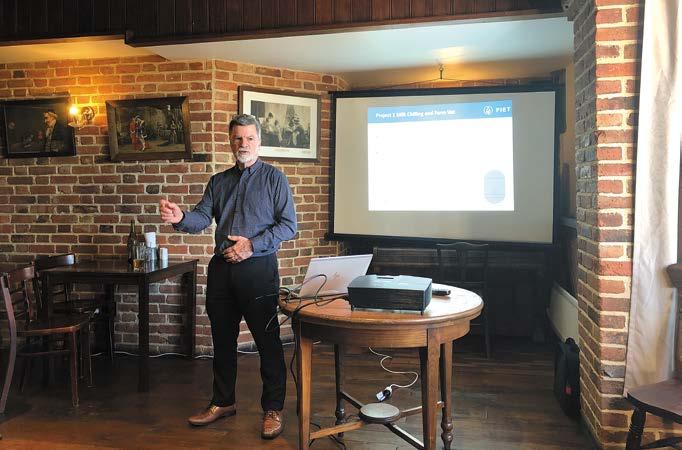
NZIFST President, Richard Archer talking to Nelson Branch members in February
Allen Foegeding: “Properties based food design” On Thursday March 19, NZIFST Central held what might be our last face-to-face branch meeting for a wee while given the strictures of Covid-19 controls imposed 48 hours later. A surprisingly large group of 18 members met in Palmerston North (virtually joined by about 4 more in Wellington and an individual member already in personal isolation) all keeping a sensible physical separation of course. Our guest was distinguished US food scientist Dr E. Allen Foegeding, whose talk was entitled “Properties Based Food Design”. Allen has a long association with New Zealand and especially Palmerston North and has previously presented to our local branch meetings. Having been in New Zealand since December, Allen was declared Covid-19- clean which facilitated his presence in person. The thrust of Allen’s talk was how a range of physical, compositional, rheological, nutritional and other food science tools might be (and are) harnessed to effect the “Ideal Food System” that best delivers affordable foods meeting the demands of an exploding human population. Allen reminded us that “engineered” foods are not a new concept with quaint post-WW2 TV advertisements for margarine extolling the similarities of this butter mimetic with its natural counterpart. Current moves to alternative sources like novel grains, fermented micro-algae, insects – and even cell-cultured alternatives to traditional foods were simply the extension of that history. The availability of recent developments in altering and measuring food structure is an enabler not previously available which should better support targeted development of nontraditional food alternatives that better deliver the properties we associate with the traditional food being copied. The session ended with a food-structure experiment on the physics of cheese mastication. Samples of different aged cheeses (thanks Fonterra) were compared for their breakdown on chewing. So far as this participant was able to tell the sole valid conclusion was that we all chew differently! As it is probable that we will all be anchored to our personal bubbles for the next who-knows-how-long, on behalf of all the Central Branch Committee I wish you all a safe transit through the period of CV-19 L4 restrictions, however long that may be, and we’ll see you hale and hearty on the other side. Stay safe, stay well.
Allan Main, FNZIFST
Nelson In late February eighteen Nelsonian's gathered at the Honest Lawyer to sink a few handles for the good of the nation. Thanks again to Foodcom for sponsoring rations. Prof Richard Archer took centre stage to update us on FIET projects and the goals of NZIFST for the coming year. We appreciate our organisation's President connecting with the regions. I know Richard enjoyed hearing from the technologists with the best work-life balance in the country (well, we think so!). Nelsonian's are always impressed by anyone who can shoot a deer from their sofa after Christmas lunch (not sure about the sofa - but we shouldn't let facts get in the way of a good story!)
David List
Canterbury Branch barbecue We like to start each year with a branch barbecue and this year we gathered again at the Halswell Quarry on 16 February. Despite the strong winds and the threat of rain, more than 16 branch members, guests and families joined the fun. Robyn Marshall (Tegel Foods) and Craig Houston (Anzco), were on the grill. Hats off to these chefs and the sumptuous meats which included a “meat free meat patty”. These meats were complemented by bread, salads and cold drinks. After the meal some members went for a walk in the quarry. All in all, a lovely, relaxing afternoon out before everything got seriously different! Allergens meeting cancelled! Katherine Campbell from Eurofins Technology in Australia was to have presented on this subject on 17th March but, like many meetings all over the country, this had to be cancelled because Katherine was to have flown in from Melbourne. Bread making courses Small Class French Baking courses were made available to Canterbury members at Vic’s Bakehouse in Ferrymead in Christchurch. Vic's Bakehouse is a small artisan bread bakery committed to baking high quality bread using traditional bread-making techniques, such as allowing time for the doughs to ferment naturally with minimal yeast
and hand moulding all bread. They have been making bread since 1999 and have a dedicated group of local customers. The maximum for a class was 8 people, so six of us met on the 15th March and were ably instructed by the passionate bakery tutor Laurie Brunot who served us coffee and fresh bagels for breakfast and then helped us to make a range of delicious breads. During the lesson we all learnt, hands-on, the techniques of kneading, folding, shaping and scoring dough. Laurie demonstrated the benefits of folding and time in place compared with more aggressive kneading, which showed us that great food is worth planning and waiting for. Laurie included some tips about overnight fermentation of dough in the fridge if we are busy during the day. We made a range of products including brioches, ciabatta, tomato bread and focaccia. At the end of the class we all went home loaded with the fresh delicious bread we had made along with the recipes and encouragement to try them at home. The small class size and industrial kitchen made the experience very personal as well as practical, and it was a great way to get to know the other members in the group. It was wonderful to be under the instruction of such a patient and able tutor and to support an established local business. A second class is planned for 17th May COVID-19 willing. I would thoroughly recommend one of these courses to anyone passionate about baked goods. Laurie runs courses throughout the year on different breads. Their website is below. https://www.vics.co.nz/baking-classes Our hearts go out to all whose businesses are being affected by the COVID-19 virus and we trust that we all get through this time before too many weeks have passed. Surely by August, when the IUFoST meeting is scheduled, the travel restrictions and large meeting cancellations will have ceased. The future is so uncertain!
Winna Harvey (FNZIFST) and Paulette Elliott (FNZIFST) Left to right, branch members Craig Houston, Jasmin Estrera and Kerin Houston with Laurie Brunot from Vic’s Bakehouse (second from right) at the bread making course

From L to R: Dr Chris Bloore, Dr Sze Leong, Prof. Indrawati Oey, Dr Biniam Kebede and Jane Bloore enjoying refreshments in the Bloore’s kitchen after Chris’ presentation

Otago/Southland A summer BBQ and powder explosions On a ‘summery’ evening in February, a small group from the OtagoSouthland branch was kindly hosted by Dr Chris Bloore (NZIFST Fellow) for an informative and entertaining seminar about powder explosions and conflagrations. Chris shared amusing anecdotes and explosive videos backed up by solid science from his 20+ years of experience as a dairy consultant. The group then huddled around Chris’ new grill for a classic Dunedin BBQ, which was a great opportunity to relax with colleagues and discuss food science and technology. Thanks very much to Chris for hosting and to Anne Gatenby for the liquid refreshments. Tour of Common Ground Espresso On the 11th March, a group visited Common Ground Espresso in Dunedin for a coffee roasting demonstration and tasting. Logan, from Common Ground, talked the group of caffeine addicts and coffee connoisseurs through the art and science of coffee roasting, including how beans are selected and how the roast profile can be controlled for maximum quality and consistency. A coffee cupping tasting was put on for the attendees with an array of single origin coffees and the same coffees roasted with different profiles to illustrate the quality differences. The group left the tour well wired and with a much better appreciation of coffee roasting and tasting. Thanks to Logan for a very ‘stimulating’ event and to Common Ground for hosting the group.
Graham Eyres, MNZIFST
COME TO NEW ZEALAND IN AUGUST 2020 AND DISCOVER WORLD-LEADING FOOD SCIENCE AND TECHNOLOGY Please watch www.iufost2020.com for latest news on the status of this event. The organisers in New Zealand look forward to running the Congress, as soon as possible.


